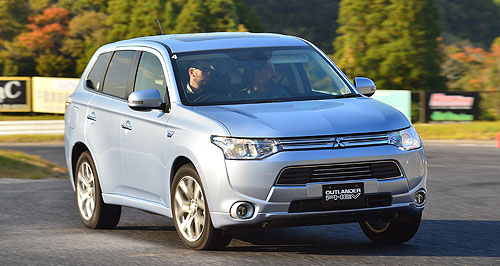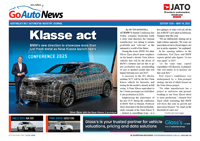News - Market Insight - Market Insight 2014Market Insight: Mitsubishi PHEV makes its markBright spark: Mitsubishi has sold 735 Outlander PHEVs in the seven months since launch, clearly finding support among buyers that other plug-in hybrids and full-electric cars have failed to achieve. Demand for Mitsubishi Outlander PHEV contrasts with general plug-in vehicle downturn17 Nov 2014 By TERRY MARTIN MITSUBISHI’S Outlander PHEV has provided the first indication that plug-in hybrid electric vehicles could become a relevant, if not significant, sector in the Australian marketplace, accumulating 735 sales from April to October to account for 12.3 per cent of the compact SUV’s overall volume. While Outlander sales have dropped 3.0 per cent over this period compared to last year, and are 4.2 per cent down for the year to date, the initial take-up rate of the plug-in hybrid version at least lends support to the proposition that PHEVs are a better fit than pure EVs in Australia, with their longer driving range and conventional engine ‘backup’. Like virtually every other company in Australia offering plug-in hybrid or electric cars, Mitsubishi has not divulged sales targets for the Outlander PHEV, which is unsurprising given the historically low support for such vehicles in a marketplace dogged by a wide variety of factors, from limited choice and buyer wariness and misapprehensions to a lack of public recharging infrastructure and government incentives. VFACTS figures show that just 205 electric vehicles have been sold in Australia to the end of October this year, a paltry figure by any measure that is down 20.8 per cent on the same period in 2013 and accounts for just 0.02 per cent of the total market. Nissan has sold 147 examples of its Leaf EV this year (-8.7 per cent), Holden has managed just 53 sales of the Volt range-extender plug-in hybrid (-44.2 per cent) and will not yet commit to selling the next-generation model here, while Renault has registered five all-electric Kangoo ZEs as part of a trial with Australia Post. Average monthly sales of electric vehicles in Australia this year is 20 – it was 24 last year, 21 in 2012 and just four per month in 2011 – while the cumulative total of electric vehicle sales in Australia is, since Mitsubishi’s now-discontinued i-MiEV launched in mid-2010, just over 900. With figures like these, the term ‘build it and they will come’ simply doesn’t apply to Australia and plug-in electrified vehicles (PEVs). Instead, building acceptance has been the mantra from the motor companies which are already offering, or have committed to launch, PEVs here. As BMW introduces its i3 in both full-electric and range-extender form to the market this month, as Audi demonstrates its A3 e-tron hybrid around the country to raise awareness ahead of its showroom arrival in March, and as Porsche prepares to add a plug-in hybrid variant to its just-launched facelifted Cayenne range, only Porsche Cars Australia chief Sam Curtis has emphasised the need to meet sales targets set by its parent company overseas. This volume is not expected to be high relative to sales of the specialist sportscar marque’s regular high-performance petrol and diesel models, as just four registrations of the plug-in Panamera since its mid-2013 launch indicates. But Porsche, like its luxury car rivals and some pioneering mainstream brands (notably Mitsubishi and Nissan), is standing by the technology as a showcase and a massive sign marking where the global superhighway is heading – albeit slowly. Cumulative global sales of PEVs (not including motorcycles, buses and trucks) passed the 500,000 mark in the second quarter of this year, a milestone that took around five years to reach. The United States accounted for the vast majority of these, around 45 per cent, followed by Japan, China, the Netherlands, France, Norway and Germany. The Leaf is leading the charge, followed by Volt, the plug-in version of Toyota’ s Prius hybrid (not sold in Australia) and the Tesla Model S, which is set to reach Australian shores by the end of this year. Accurate statistics are hard to come by, but overseas reports indicate that the 600,000 mark has since been reached, with 700,000 expected by year’s end and the million-unit mark anticipated early in the second half of 2015 – figures that show that while the road to acceptance is long and hard, the global market is at least gathering speed. Significantly, the United Kingdom is among the fastest-growing markets and a top-eight nation in terms of outright PEV sales, with more than 10,000 sales to the end of October this year. New registrations of full EVs in the UK have more than doubled so far this year to around 5000 units, while plug-in hybrid and range-extender sales have almost quadrupled to also breach the 5000-unit mark. All up, sales of alternatively fuelled vehicles in the UK this year – with two months left to run – are 12,000 units ahead of last year’s record full-year total of 32,715, which was up 20 per cent on the previous year. According to the British Society of Motor Manufacturers and Traders (SMMT), the key to this surge in popularity is a constantly increasing range of models. In 2011, there were just six plug-in models – now there are 20 to choose from, in a wide range of body styles. Australia is at the back of the grid, but with new models approaching there will at least be more vehicles in the marketplace with which to build upon the general lack of interest and awareness – and the little spark provided by the Outlander PHEV.  Read more13th of November 2014  Driven: BMW i3 launches in Oz at lastRange extender hybrid version of BMW’s i3 predicted to be the best seller12th of November 2014  Audi says now is the time for PHEVsSlow-burn plug-in hybrid vehicles will become accepted like diesel power says Audi11th of November 2014  Driven: Porsche spices up CayenneMid-life update for Porsche’s Cayenne SUV brings efficiency gains and plug-in hybrid25th of August 2014  A3 just the start of Audi’s Aussie e-tron onslaughtPlug-in Q7 SUV odds-on to be Audi Australia’s next e-tron, could arrive next year31st of March 2014  Plug-in ‘hangover’ made dealers wary: MitsubishiMitsubishi Outlander PHEV a hard sell to the public and its own dealers alike21st of March 2014  Driven: Mitsubishi Outlander plug-in arrivesMitsubishi releases ground-breaking Outlander PHEV plug-in from a sharp $47,490 |
Click to shareMarket Insight articlesResearch Market Insight Motor industry news |


















Facebook Twitter Instagram